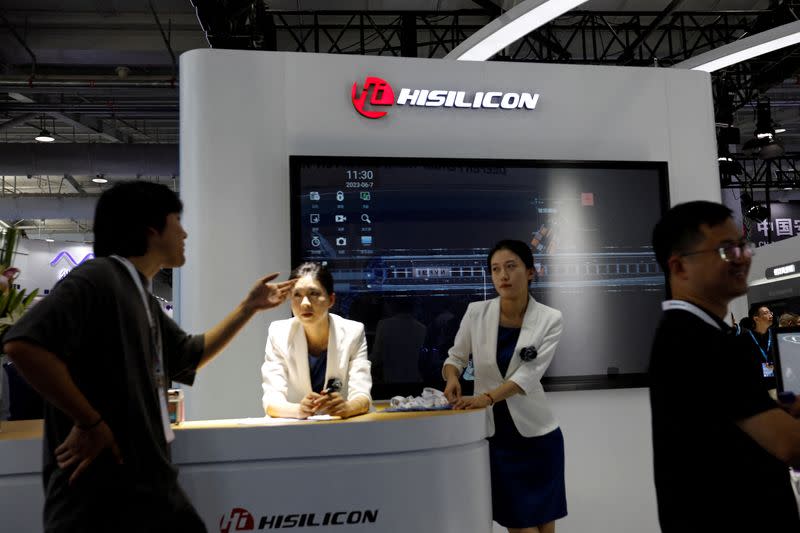HiSilicon chip design unit – a division of Huawei Technologies – is selling new Chinese-made chips for surveillance cameras.
Sources say the news shows that the Chinese tech giant is finding ways around sanctions imposed by the US four years ago.
The shipments to surveillance camera manufacturers from the HiSilicon chip design unit started this year, according to one of the sources, and a third source familiar with the industry supply chain. One of the sources said some of the customers were Chinese.
ALSO SEE: Huawei to Hold Product Event; All Eyes on Tech, Chip Details
Huawei also unveiled new smartphones in recent weeks that use advanced chips, which analysts say are domestically made.
The developments indicate the Chinese tech giant is overcoming US export controls, which have barred it from obtaining components and technology from US firms without approval since 2019.
“These surveillance chips are relatively easy to manufacture compared to smartphone processors,” said the source familiar with the surveillance camera industry’s supply chain, adding that HiSilicon’s return would shake up the market.
‘Breakthroughs in design tools’ for 14nm chips and above
A key factor is that the company appears to have worked around US restrictions on chip design software.
Huawei in March announced it had made breakthroughs in design tools for chips produced at and above 14 nanometres – two to three generations behind leading-edge technology, but an advance for the company.
HiSilicon mainly supplies chips for Huawei equipment but has had external customers such as Dahua Technology and Hikvision.
Before the US export controls, it was the dominant chip supplier to the surveillance camera sector, with brokerage Southwest Securities estimating its global share in 2018 at 60%.
By 2021, HiSilicon’s global market share plummeted to just 3.9%, according to data from consulting firm Frost & Sullivan.
One of the sources briefed on the unit’s efforts said that HiSilicon had shipped some low-end surveillance chips since 2019 but that its focus was on the high-end arena and reclaiming market share from the likes of Taiwan’s Novatek Microelectronics Corp.
All three sources declined to be named because of the sensitivity of the matter. Huawei also declined to comment.
Mate 60 Pro smartphone
Huawei drew attention in late August when it rolled out the Mate 60 Pro, a new smartphone that uses an advanced chip and that users said was capable of 5G speeds.
The event was cheered by Chinese state media and the public as a comeback for Huawei’s smartphone business after it was crippled by the US sanctions.
Research firm TechInsights, which examined the Mate 60 Pro, found that it was powered by a new Kirin 9000S, an advanced chip it said was most likely made in China by China’s top chip foundry, Semiconductor Manufacturing International Corp (SMIC).
Huawei has not commented on the phone’s 5G capabilities or how it produced the advanced chip. The Kirin series has historically been designed by HiSilicon, and before the US sanctions Huawei, worked with Taiwan’s TSMC to manufacture it.
The launch prompted calls from US lawmakers to put additional pressure and “more effective export controls” on Huawei and China’s top chip foundry, Semiconductor Manufacturing International Corp (SMIC).
The United States has no evidence that Huawei can produce smartphones with advanced chips in large volumes, US Commerce Secretary Gina Raimondo said on Tuesday.
The US sanctions have strangled HiSilicon’s access to electronic design automation (EDA) software from Cadence Design Systems and Synopsys, and Siemens’s Mentor Graphics. The three companies’ products dominate the chip-design sector, which produces blueprints for chips before they are mass manufactured.
TechInsights analyst Dan Hutcheson said their analysis of the Mate 60 Pro and other components such as its radio frequency power chip also suggested that Huawei had access to sophisticated EDA tools that “they are not supposed to have”.
“We don’t know if they got them illicitly, or more probably the Chinese developed their own EDA tools,” he said.
- Reuters with additional editing by Jim Pollard
ALSO SEE:
For China Users, an Apple vs Huawei Battle is Picking up Pace
Threat of More Chip Curbs Spurs Warnings on China Innovation
New Huawei Phone Made With ‘50% More Homegrown Chip Parts’
Key US Lawmaker Wants End to Chip Exports to Huawei, SMIC
Huawei’s Chip Breakthrough ‘May Spur Tougher US Tech Curbs’
New Huawei Phone Spurs Fear China Got Around US Chip Curbs
China Plans $40bn Bonanza for Chips After Huawei Breakthrough























